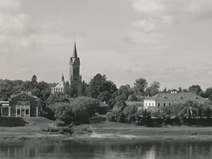Birštonas with its well-established wooden castle on Nemunas slope was first mentioned in the Chronicle of New Prussia of Wigand of Marburg in the XIV century. After the defeat of Teutonic Knights in the Battle of Grunwald, Birštonas was for a while known as the hunting estate of the dukes of the Grand Duchy of Lithuania. Until the mid XVI century the city was naturally grew in a linear plan. During 1555-1563 it was expanded to the west and the east by applying a rectangular (Gothic) plan common for urban reforms at that time. However, Birštonas as a trade and crafts city appeared to be overrated and was quickly pushed out of the market by nearby Prienai in the late XVI century, leading to the abandonment of the newly designed street network. As a result, Birštonas became one of the few Lithuanian cities not to adopt the standard rectangular plan and in XVII – early XIX centuries the city formed a completely new unique street network[1].
The revival of Birštonas began in the mid XIX century after learning about the therapeutic effect of the mineral waters found in the area. “It is known that doctor Benediktas Balinskis who worked in Stakliškės resort brought a patient to Birštonas in 1846 who was treated by the local waters. In 1854 Birštonas received an official permission to provide treatment by mineral waters.”[2] The use of therapeutic water required infrastructure which spurted the urban development of Birštonas as a balneological resort. At that time Birštonas only had about 30 houses, while in 1861 the number already reached 52. Urban development of Birštonas was encouraged by the fire that broke out in the nearby Stakliškės resort in 1857, after which the resort lost all of its value. Birštonas was built according to the street network that emerged in the early XIX century: “along the street leading to the resort (in the southern part of the city) and along the road leading to Prienai. These were small wooden peasant huts[3]”. Although in the second half of the XIX century Birštonas was already a well-known balneological resort in Russian Empire, its look was similar to most other Lithuanian villages. It only got its characteristic urban composition in the early XX century, following the erection of a Neo-Gothic church, larger residential houses and public buildings, and treatment facilities. “Just before the First World War city's treatment facilities had a total of 72 baths, while the city had 3 hotels with a total capacity of 200.”[4]
Birštonas was hard-hit by World War I and was nearly abandoned due to the lack of funds for its rebuilding in the early years of Lithuanian independence. In this case, Lithuanian Red Cross organization played a crucial role by offering to modernize Birštonas in 1924 and building the first modern treatment facilities in the city. All profit of Red Cross sanatorium went towards the development of infrastructure. The organization built a modern Red Cross treatment complex, installed electricity, water supply, and sewerage in hotels, allowing the only Lithuanian treatment resort to be able to serve a large number of visitors by the 40s. “Thanks to Red Cross's board, we sorted out the park, built a fountain, set up reservoirs for fresh and mineral water on Vytautas Hill, [...] arranged regular commutes to Kaunas and Alytus. The city saw a growth of sanatoriums and villas, it became nicer, expanded.”[5] By the time it became the centre of the parish in 1933, it already had a market and more than a dozen commercial establishments. At that time, Birštonas was still expanding according to the same composition which formed in the XIX century; it had its central square restored, where in 1939 a monument for patriarch J. Basanavičius was built. Its restructuring plans drawn up in the late 30s, which were supposed to radically change its historical plan, were not implemented due the outbreak of World War II. During the Soviet period, its cityscape, which used to be dominated by one-storey houses with attics, changed significantly: residential zones were built up by typical blocks of flats; new massive treatment complexes were designed.
[1] Miškisnis A. Birštono miesto istorinis-urbanistinis vystymasis. Lietuvos TSR architektūros klausimai. Vilnius: 1974, p. 186-187.
[2] Birštono kurortas XIX a. Online Access: http://kvitrina.com/?p=50979.
[3] Miškisnis A. Op. cit., p. 180.
[4] Birštono turizmo informacijos centro informacija.
[5] Ibid.
